Then and Now
News from the History Department at Miami University - Summer 2015
Chair's Welcome
As we head into a hot and steamy Ohio summer, we can look back with pride on our work of the past year—that of our faculty as well as our students. I hope this newsletter will give you a sense of the range and significance of these accomplishments. This year has also been marked by great transitions for the History Department.
 We successfully completed the searches for three new faculty in U.S. History: Dr. Steven Conn will assume the W.E. Smith Chair in American History, and Drs. Lindsay Schakenbach Regele and Andrew Offenburger will join us as tenure-track assistant professors. We look forward to welcoming them in the fall.
We successfully completed the searches for three new faculty in U.S. History: Dr. Steven Conn will assume the W.E. Smith Chair in American History, and Drs. Lindsay Schakenbach Regele and Andrew Offenburger will join us as tenure-track assistant professors. We look forward to welcoming them in the fall.
Of our current faculty, Charlotte Newman Goldy and Peggy Shaffer were promoted to professor, while four others, Elena Jackson Albarrán, Nishani Frazier, Tatiana Seijas, and Susan Spellman were tenured and promoted to associate professor. Renée Baernstein accepted an appointment as Associate Dean of the College of Arts and Science. Congratulations to all.
At the same time we have said good-bye to several valued colleagues. Last summer Mary Frederickson decided to retire to continue her research appointment at Emory University. W. Sherman Jackson and Robert W. Thurston are now fully retired having completed their terms as “retire-rehire” faculty. Mary Kupiec Cayton retired as well and has accepted a teaching position in the History Department at The Ohio State University. Andrew R.L. Cayton will take up the Warner Woodring Chair in Early American History, also at OSU. Tatiana Seijas is moving to a tenured position at Penn State.
We are enormously grateful for everything these colleagues have contributed—their scholarship, teaching, and friendship—over the last decades. We will miss them and wish them the best in their future pursuits.
For this new chair it has been an exciting year. Amidst all the changes we are facing I have been heartened by the commitment, enthusiasm, and sense of common purpose of our department. I look forward to the next year and hope to hear from you!
Wietse de Boer
Chair, Department of History
How You Can Help Current Students
Today's students are encouraged to pursue internships, study abroad, or take classes that involve traveling to a region they are studying, or to museums and archives. Others travel on their own to do research for an Honors or M.A. thesis. A contribution of any size will help these undergraduate or graduate students take advantage of these opportunities. Being able to travel to archives or attend a conference would greatly enrich their Miami education.
But we would also appreciate your engagement with our students! Do you have internship opportunities to offer students? Would you be interested in discussing with current students how you went from a satisfying Miami History major to a satisfying career? Let us know. We would be happy to bring you to campus to share your post-Miami experiences in one of our new series of career workshops!
Students Studying Abroad: Making History at the Last Post
by Stephen Norris
During the 2015 Winter Term, students enrolled in “The Great War at 100” workshop not only studied history, they made it. Three of them—Sam Colleran, Victoria Cooke, and Riley Kane--became the first Miami students to take part in the Last Post held every night in Ypres, Belgium.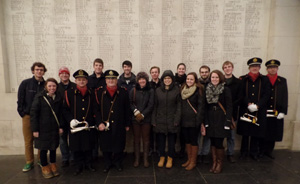
Every day at 8 PM, a ceremony is held underneath the Menin Gate in Ypres. The Last Post, the traditional British bugle call, is sounded by members of the local association dedicated to remembering the Great War’s dead. The setting is a somber one: the Menin Gate was built after the war and bears the name of 54,896 British soldiers who died around Ypres and whose bodies were never recovered. Designed by Sir Reginald Blomfield and dedicated on July 24, 1927, the Menin Gate is also inscribed with Rudyard Kipling’s words: “Here are recorded names of officers and men who fell in Ypres Salient, but to whom the fortune of war denied the known and honoured burial given to their comrades in death.”
 On July 2, 1928, citizens of Ypres held the first nightly ceremony underneath the memorial. It has been held every night since, but was moved to England during the occupation of Belgium in World War II. On the day the Germans left Ypres in 1944, the ceremony was performed again under the memorial and has been held there every day since. Siegfried Sassoon, the British poet who survived his time at the front, would characterize the memorial as a “sepulchre of crime” in his poem “On Passing the New Menin Gate” and suggested that the dead “who struggled in the slime” would rise up to condemn it. The Australian painter Will Longstaff would envision something similar in his canvas, The Menin Gate at Midnight, which he completed after attending the ceremony and reportedly seeing a “vision of steel-helmeted spirits rising from the moonlit cornfields around him.”
On July 2, 1928, citizens of Ypres held the first nightly ceremony underneath the memorial. It has been held every night since, but was moved to England during the occupation of Belgium in World War II. On the day the Germans left Ypres in 1944, the ceremony was performed again under the memorial and has been held there every day since. Siegfried Sassoon, the British poet who survived his time at the front, would characterize the memorial as a “sepulchre of crime” in his poem “On Passing the New Menin Gate” and suggested that the dead “who struggled in the slime” would rise up to condemn it. The Australian painter Will Longstaff would envision something similar in his canvas, The Menin Gate at Midnight, which he completed after attending the ceremony and reportedly seeing a “vision of steel-helmeted spirits rising from the moonlit cornfields around him.”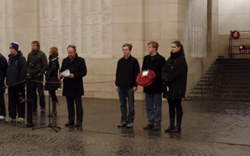 Miami students taking part in the Last Post ceremony.
Miami students taking part in the Last Post ceremony.
(L to R) Sam Colleran, Riley Kane, Victoria Cooke.
No spirits of the dead appeared around the gate on January 12, 2015, when twelve students attended the ceremony. Hosted by Miami’s Luxembourg campus, we had spent a few days in the chateau at Differdange discussing the war on the occasion of its centenary. After a 4-day study tour that brought Miami History students to Verdun, the Somme, and Ypres, we gained an appreciation for the ways the Great War continues to matter. From the landscapes still ruined by shells to the innumerable cemeteries that dot the region, the Great War remains a visible part of contemporary France and Belgium. Taking part in the Last Post proved to be the best possible reminder of this fact.
To read what the students on the Great War at 100 workshop wrote about their experiences, visit the class blog.
You can also watch four students talk about their experiences on the College of Arts and Sciences YouTube channel.
Annette Gordon-Reed Lecture on Thomas Jefferson and Sally Hemings
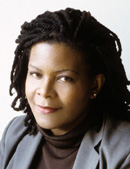 On April 1 National Book Award recipient and Pulitzer Prize winning historian Annette Gordon-Reed gave a lecture entitled “Constituting ‘The People’: Law and Legacies of Slavery” in the Wilks Theatre at the Armstrong Student Center.
On April 1 National Book Award recipient and Pulitzer Prize winning historian Annette Gordon-Reed gave a lecture entitled “Constituting ‘The People’: Law and Legacies of Slavery” in the Wilks Theatre at the Armstrong Student Center.
Professor Gordon-Reed is a professor of American Legal History at Harvard Law School and a professor of History at Harvard University. She was invited to deliver the Charles R. and Elizabeth C. Wilson Lecture in History in association with the A. Andrew Olson Lecture Series in Early American History in Honor of Andrew Cayton. She discussed her award-winning research about Thomas Jefferson and his family lineage, in particular Jefferson’s controversial relationship with his slave, Sally Hemings.
In her first book, Thomas Jefferson and Sally Hemings: An American Controversy, published in 1997, Gordon-Reed weighed evidence regarding a centuries-old claim that Thomas Jefferson had a sexual relationship with his 16-year-old slave, Sally Hemings, and had children with her. Historians had conventionally discarded these accusations after sifting through various letters written by Jefferson.
“They did not question [the letters’] credibility,” Gordon-Reed said. “They did not want it to be true.”
Gordon-Reed added that she did not find this kind of relationship between slave and slave-owner peculiar.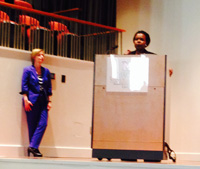
“It didn’t strike me as odd that slave owners would have children with their slaves,” she said. “I grew up in Texas, in the South. African American people know, especially at family reunions, people there are all different colors. There is evidence of mixture everywhere. This isn’t something that is strange or odd.”
After DNA testing revealed a link between Jefferson and the Hemings family, Gordon-Reed dedicated her research to “bringing Sally Hemings to life.” Her book, The Hemingses of Monticello: An American Family,” was published in 2008 and won the Pulitzer Prize in History.
“If I could write something that helped make the Hemingses individuals,” instead of their being “treated as a sort of monolithic archetype…, that might make a difference in the future,” she said.
Faculty Spotlight: Professor Elena Albarrán
In January 2015, Professor Albarrán published a historical study entitled Seen and Heard in Mexico: Children and Revolutionary Cultural Nationalism (University of Nebraska Press).
Q: What was the inspiration behind your book?
EA: During my undergraduate and graduate careers, I studied, lived, and traveled extensively in Mexico. I was always struck by the child-centered nature of the country, on one hand, and the high visibility of child poverty and socioeconomic inequality, on the other hand. After trying multidisciplinary approaches to understand the phenomenon, including anthropology and art therapy, I realized that History provided me with the right tools for me to engage with this lingering query.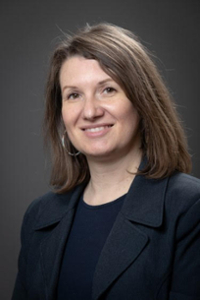
Revolutions often result in a transformation of the relationship of the state to its citizens. Following the Mexican Revolution (1910-1920), the new government engaged in a comprehensive effort to incorporate the wider population into national politics, economic production, and culture. This was carried out through the vast and deep expansion of the education system. Since children were the primary targets of this system, I wanted to know how they experienced the major cultural innovations that inundated them in the decades following the revolution.
I found evidence of children’s participation in the construction of cultural nationalism in the following domains: puppet theater, radio programming, the art curriculum, children’s magazines, children’s political conferences, literacy campaigns, Boy Scouts, and the Junior Red Cross. These sources allowed me to draw the conclusion that during the period 1920-1940, there was an unprecedented opening of physical and cultural spaces for children, and that resulted in more visible participation of children in the process of nation building. They sometimes embraced, other times rejected, and oftentimes misunderstood the official rhetoric of cultural nationalism that was directed at them. But importantly, this period was also marked by quite uneven access to the child-centered cultural domain—often marginalizing the rural and indigenous children from the modernizing auspices of the Mexican education program.
Q: Where did you do research for your book?
EA: I conducted nearly all of my research in about a dozen archives in Mexico City, and a few libraries and archives in the U.S. I love the adrenaline rush (yes, the pursuit of history can actually produce adrenaline!) of tracking down a rare book, piece of correspondence, or periodical. Much of my source material for one chapter came from a popular children’s magazine from the 1920s that had been printed on cheap paper; most issues had not survived. It was not held by any archive in Mexico City. Somehow I got linked to a “dealer”—an antique book dealer, that is—who contacted me whenever he had a lead on an issue of this elusive magazine that turned up whenever he received a new estate sale. I would receive furtive texts from my dealer, and I would flee social situations to meet him at a plaza or street corner to exchange cash for these treasured magazines.
Q: How did your teaching and/or students influence this project? 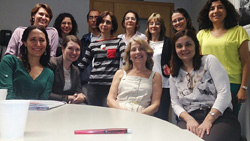
EA: It’s worth mentioning that when I started research on this project, no grant agency would fund it. At the time, childhood studies were in their infancy—pun intended—and a dissertation/monograph that prioritized child-produced sources (drawings, letters, marginalia, speeches, autobiographies) was considered untenable or trivial. Since then, the field of childhood studies has exploded. It has led me to conferences and collaborations beyond Mexico to Sweden, Hong Kong, Germany, and Argentina. I have taught two childhood-related capstones in History and Latin American Studies. And I’ve just joined the organizing committee of a newly-formed network of historians of Latin American childhood. We signed the governing document yesterday in Buenos Aires.
Albarrán photo caption (Dr. Albarrán is front row, second from left):
Dr. Albarrán with the rest of the founding members of the Red de Historiadores de las Infancias en América Latina (or Network of Historians of Latin American Childhoods) taken after our inaugural meeting in April 2015 in Buenos Aires. The group was made up of delegations from Argentina, Chile, Brazil, Mexico, and the United States. As one of the Brazilian members said, "This is a historic moment."
History Major Spotlight: Alex Filice
In the summer of 2014 Undergraduate Summer Scholar Alex Filice researched the history of the American Revolution, focusing in part on the debate over the position of the president of the new country. Filice researched this era through the letters and writings of Gouverneur Morris, one of the founding fathers and a signer of the Articles of Confederation. Morris is also credited as the author of the Preamble of the Constitution.
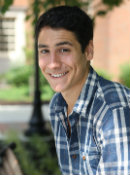 Morris "advanced the idea of being a citizen of a single union of states, rather than citizens of their respective states," Filice said. Morris was also a valuable chronicler of the French Revolution, having traveled extensively in Europe and serving as minister to France from 1792 to 1794.
Morris "advanced the idea of being a citizen of a single union of states, rather than citizens of their respective states," Filice said. Morris was also a valuable chronicler of the French Revolution, having traveled extensively in Europe and serving as minister to France from 1792 to 1794.
During the French Revolution Morris wrote letters extensively to George Washington. Comparing the American and French Revolutions, "America took it in one direction and got a president; France beheaded their king and the result was chaos," Filice said.
Filice became involved in this research when his mentor, Tatiana Seijas, assistant professor of history, pulled him aside after class one day and suggested he apply to the USS program. The rest is history: a great chance to "get paid to do what I love," he said.
During the 2014-15 academic year Filice turned his research into a senior honors thesis and presented it before graduation at the History Honors Symposium, held on April 29-30, 2015. Other graduating History Honors students presenting their work at this occasion included:
- Steven Darnell, “Johann Ewald and America: A Study on the Changing Perceptions in European Military Affairs as Influenced by the American Revolution and the Trans-Atlantic World”
- Shea Hendry, “A Spartan Confederacy: Classical Discourse in the Southern Intellectual Life, 1780-1865”
- Kelly Irwin, “Analyzing the Female Humanist’s Character: How Paolo Giovio’s Assessment of Illustrious Women Aligned with Italian Renaissance Discourse”
- Amanda Lawson, “Perfect Partnership: the Disney Studio and the United States Government During World War II”
- Grant Lemasters, “The American Abroad: The Experiences of Paul Lemasters in the South Pacific, 1944-1945”
- Michael Putz, “Science, Mercantilism, Empire: Colonial Development and Nature on Barbados, 1627-1700”
- Andrew Sullivan, “Architect of Destruction: The German Armaments Ministry and Albert Speer, 1936-1945”
- Cassondra Willoughby, “The Church and the Foreign State: The Impact of American Missionaries on Turn-of-the-Century Korea”
Alumni News
DANIEL M. MASTER, who received his M.A. in History at Miami in 1995 and his Ph.D. at Harvard in 2001, has been promoted to full professor of Bible and Archaeology at Wheaton College, Wheaton, Illinois. He has also succeeded his mentor, Lawrence Stager of Harvard, as the field director at Ashkelon, Israel, one of the largest excavations in the area.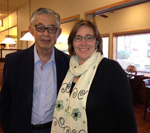
Miami Ph.D. graduate DARLENE BROOKS HEDSTROM (pictured, right) was promoted to full professor at Wittenberg University. Photo: Dr. Brooks Hedstrom with her advisor, Professor Emeritus Edwin Yamauchi.
JESSICA SINK ’12 is now a law student at Ohio Northern College of Law. Jessica was a double major in history and strategic communications, and an undergraduate assistant in history.
KUDOS: History Faculty News, Publications, and Awards
ELENA JACKSON ALBARRÁN
- Seen and Heard in Mexico: Children and Revolutionary Cultural Nationalism, University of Nebraska Press, 2014.
- “El niño proletario: Jesús Sansón Flores and the New Revolutionary Redeemer, 1935-1938,” in Mexico in Verse: A History of Music, Rhyme, and Power, eds. Stephen Neufeld and Michael Matthews. Tucson: University of Arizona Press, 2015. Pp. 218-256.
SHELDON ANDERSON
- “The Responsibility to Protect,” in Sheldon Anderson, Mark Peterson, Stan Toops, and Jeanne Hey. International Studies: An Interdisciplinary Approach to Global Issues (third edition). Boulder: Westview Press, 2014.
- “North America and International Studies,” with Mark Peterson and Stan Toops. in Sheldon Anderson, Mark Peterson, Stan Toops, and Jeanne Hey. International Studies: An Interdisciplinary Approach to Global Issues (third edition). Boulder: Westview Press, 2014.
P. RENÉE BAERNSTEIN
- College of Arts and Science Distinguished Educator, 2014-15.
- Altman Scholar, 2014-15.
- Appointed Associate Dean of CAS, 2015.
- “The Nuns of Early Modern Italy: New Directions in Anglophone Scholarship,” La storia di genere in Italia in eta moderna: Un confront tra storiche nordamericane e italiane, Elena Brambilla and Anne Jacobson Schutte, eds., Viella, 2014.
WIETSE DE BOER
- Co-editor, with Giuseppe Marcocci, Aliocha Maldavsky and Ilaria Pavan, Space and Conversion in Global Perspective, Intersections 35, Brill, 2014.
- "The Counter-Reformation of the Senses," Ashgate Research Companion to the Counter-Reformation, ed. Mary Laven, Alexandra Bamji, and Geert Janssen, Ashgate, 2013.
MATTHEW S. GORDON
- “Ibn Tulun, al-Qata’i and the Legacy of Samarra” in Hundert Jahre Grabungen in Samarra (Beitrage zur Islamischen Kunst und Archaologie, Bd. 4), ed. Julia Gonnella, Dr. Ludwig Reichert Verlag, 2014.
- “Ahmad ibn Tulun and the Politics of Deference” in Islamic Cultures, Islamic Contexts: Essays in Honor of Professor Patricia Crone, ed. Behnam Sadeghi et al., Brill Publishing, 2015.
- “The Collapse of the Abbasid Caliphate and the Arab/Islamic Empire,” in World History: Ancient and Medieval Eras, ABC-CLIO, online article, 2014.
KIMBERLY HAMLIN
- Margaret W. Rossiter History of Women in Science Prize, History of Science Society, for the article “The Case of the ‘Bearded Woman’: Hypertrichosis and the Construction of Gender in the Age of Darwin,” November 2014.
AMANDA McVETY
- “Fear, Want, and the Internationalism of the Early Cold War” in The Routledge Handbook of the Cold War, ed. Artemy M. Kalinovsky and Craig Daigle, Routledge, June 2014.
YIHONG PAN
- “Never a Man’s War: The Self-Reflections of the Women Soldiers of the New Fourth Army in the Resistance War against Japan (1937-45).” In Chinese. Research on Women in Modern Chinese History, issue 24, December 2014.
DANIEL PRIOR
- Awarded research appointments to work on an abridged translation of the “classic” version of the Kirghiz epic Manas written down from oral performances by the bard Sagymbai Orozbakov in the 1920s.
- Committee for Faculty Research (CFR) Summer Research Appointment in summer 2015, and the following fall as a Foreign Visiting Fellow at the Slavic-Eurasian Research Center, Hokkaido University, Sapporo, Japan.
MARSHA ROBINSON
- “A Review of Strategic Resource Allocation in Precolonial Good Governance Models in Africa,” Kenya Scholars and Studies Association, University of North Alabama, September 4, 2014.
- “The Unfinished Project of J. J. Bachofen and the Gender Wars on the Home Front,” Swiss American Historical Review, February 2015.
TATIANA SEIJAS
- Asian Slaves in Colonial Mexico: From Chinos to Indians, Cambridge University Press, 2014.
HELEN SHEUMAKER
- “Secondhand Learning: Using Secondhand Consumerism in the Classroom” in Shopping: Material Culture Perspectives, Deborah Andrews, ed., University of Delaware Press, 2014.
JACK WHITE
- 2015 recipient of the Captain Donald T. Wright Award from the Herman T. Pott National Inland Waterways Library. The award is to “notable authors and journalists of distinguished river-related literature.”


